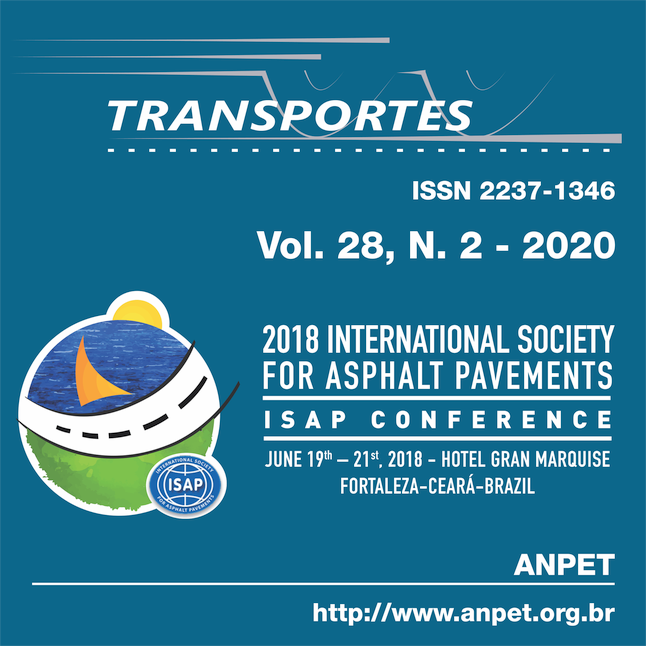Adhesion at asphalt-aggregate interface through surface energy
DOI:
https://doi.org/10.14295/transportes.v28i2.2071Keywords:
Moisture Damage, Adhesion, Cohesion, Limestone, Sandstone, Surface Free Energy, Humidity Damage Index(IDH).Abstract
One of the most common problems pavements have is the loss of adhesion and cohesion due to moisture damage. Tropical countries and rainy seasons are some of the causes for this type of distress on roads. Another factor that has high influence in this damage is the mineralogy of the aggregate. This research shows the results of adhesion and cohesion between the aggregates from a limestone quarry and two types of sandstones from different quarries, highly used for roads projects from Colombia, and the asphalt 60-70 (1/10) mm, same PG58-22. For determining the adhesion and cohesion, Bitumen Bond Strength tests were made for dry and wet conditions. In addition, the Surface Free Energy was measured for the aggregates and the asphalt. The results indicated that those type of aggregates are highly susceptible to moisture damage, due all values of humidity Index Damage (HDI) were less than 0,5. This indicates that it is necessary to use modifiers for controlling the stripping of the pavements due to Moisture Damage.
Downloads
References
Bhasin, A., Little, D. N., Vasconcelos, K. L., & Masad, E. (2007). Surface Free Energy to Identify Moisture Sensitivity of Materials for Asphalt Mixes. Transportation Research Record, 2001(1), 37–45. DOI: 10.3141/2001-05
Caro-Spinel S, Masad E, Bhasin A, Little DN. “Moisture susceptibility of asphalt mixtures, Part 1: mechanisms”. Int J Pavement Eng - INT J PAVEMENT ENG. 2008;9(2):81-98
Kiggundu, B. M., & Roberts, F. L. (1988).” Stripping in HMA mixtures: State-of-the-art and critical review of test methods” (No. NCAT Report No. 88-2). Auburn, AL: National Center for Asphalt Technology.
Terrel, R L., Saleh A, & Todd V. S. (2011). “Equipment and Method for Environmental Testing of Bituminous Specimens (Con-cesión)”. Oregon: Oregon State University.
Nicholson, V. (1932). “Adhesion tension in asphalt pavements, its significance and methods applicable in its determination (Monograph)”. Highway Research board Bibliography.
McCann, M., Anderson-Sprecher, R., & Thomas, K. P. (2005). “Statistical comparison between SHRP aggregate physical and chemical properties and the moisture sensitivity of aggregate-binder mixtures”. Road Materials and Pavement Design, 6(2), 197-215.
Solaimanian, M., Fedor, D., Bonaquist, R., Soltani, A., & Tandon, V. (2006). “Simple performance test for moisture damage prediction in asphalt concrete (with discussion)”. Journal of the Association of Asphalt Paving Technologists, 75.
Moraes, R., Velasquez, R., & Bahia, H. (2011). “Measuring the effect of moisture on asphalt-aggregate bond with the bitumen bond strength test”. Transportation Research Record: Journal of the Transportation Research Board, (2209), 70-81.
Figueroa, A., Velásquez, R., Reyes, F., & Bahia, H. (2013). “Effect of Water Conditioning for Extended Periods on the Properties of Asphalt Binders”. Transportation Research Record: Journal of the Transportation Research Board, (2372), 34-45.
Aguiar-Moya, J. P., Loria-Salazar, L., Salazar, J., Villegas, E., Corrales-Azofeifa, J. P., Hajj, E. Y., & Center, W. R. S. (2013). Evaluation of Adhesion Properties of Costa Rican Asphalt Mixtures using the Bitumen Bond Strength (BBS) and Contact Angle Measurement Tests. En 92th Annual meeting of the transportation research board, Washington, USA.
Chaturabong, P., & Bahia, H. U. (2018). Effect of moisture on the cohesion of asphalt mastics and bonding with surface of aggregates. Road Materials and Pavement Design, 19(3), 741-753.
Schrader, M. E. (1995). Young-dupre revisited. Langmuir, 11(9), 3585-3589.
Bhasin, A., Little, D., Vasconcelos, K., & Masad, E. (2015). Surface free energy to identify moisture sensitivity of materials for asphalt mixes. Transportation Research Record: Journal of the Transportation Research Board, 2001, 37-45.
Caro-Spinel, S., & Alvarez-Lugo, A. E. (2011). Evaluación de la susceptibilidad al daño por humedad de mezclas asfálticas empleando propiedades termodinámicas. Revista Facultad de Ingeniería, (58), 95-104.
Downloads
Published
How to Cite
Issue
Section
License
Authors who submit papers for publication by TRANSPORTES agree to the following terms:
- The authors retain the copyright and grant Transportes the right of first publication of the manuscript, without any financial charge, and waive any other remuneration for its publication by ANPET.
- Upon publication by Transportes, the manuscript is automatically licensed under the Creative Commons License CC BY 4.0 license. This license permits the work to be shared with proper attribution to the authors and its original publication in this journal.
- Authors are authorized to enter into additional separate contracts for the non-exclusive distribution of the version of the manuscript published in this journal (e.g., publishing in an institutional repository or as a book chapter), with recognition of the initial publication in this journal, provided that such a contract does not imply an endorsement of the content of the manuscript or the new medium by ANPET.
- Authors are permitted and encouraged to publish and distribute their work online (e.g., in institutional repositories or on their personal websites) after the editorial process is complete. As Transportes provides open access to all published issues, authors are encouraged to use links to the DOI of their article in these cases.
- Authors guarantee that they have obtained the necessary authorization from their employers for the transfer of rights under this agreement, if these employers hold any copyright over the manuscript. Additionally, authors assume all responsibility for any copyright infringements by these employers, releasing ANPET and Transportes from any responsibility in this regard.
- Authors assume full responsibility for the content of the manuscript, including the necessary and appropriate authorizations for the disclosure of collected data and obtained results, releasing ANPET and Transportes from any responsibility in this regard.









